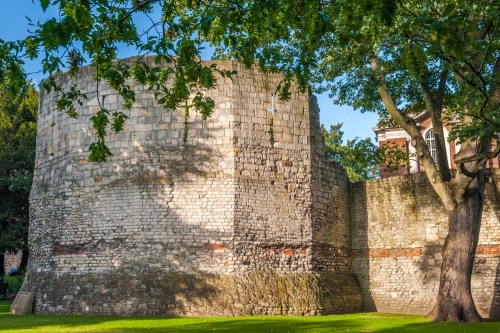
Tucked into a leafy corner on the north side of York's Museum Gardens is the finest example of a Roman structure in the city. The Multangular Tower stands between the Yorkshire Museum and the medieval St Leonard's Hospital.
It was one of eight similar towers and one of two defending the west side of the Roman legionary fortress of Eboracum facing the River Ouse. The lower part of the tower is Roman but the upper section was rebuilt in medieval times and has several 13th-century arrow slits. You can clearly see layers of Roman tiles used in the Tower's construction.
History
The stone wall defending Eboracum was almost certainly the work of Emperor Septimius Severus, who visited York in AD 209. The stone wall probably replaced an earlier turf and timber wall built in AD 70 during the first Roman expansion into the north of England.
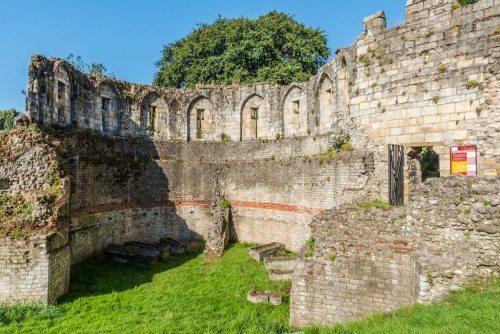
It seems likely that the Multangular Tower was built a century after the stone wall, under Emperor Constantine the Great (310–320). It seems highly unlikely that Eboracum was ever intended to be a fortress; its role was to assert Roman control over the north of England.
The Roman parts of the Tower date to the early 3rd century. It projected from the fortress wall, giving defenders a good angle to fire on anyone attacking the wall. A low foundation plinth adds stability to the Tower base. You can see the damage caused by Civil War cannonballs on the north face of the Tower.
The peculiar name gives a clue as to the Multangular Tower's shape. Though at first glance the Tower may appear rounded, it is actually ten-sided, though the design is that of a fourteen-sided figure. The remaining four sides were left open to allow for access to the Tower from the rear. The Tower was probably divided into three floors topped with a wooden roof.
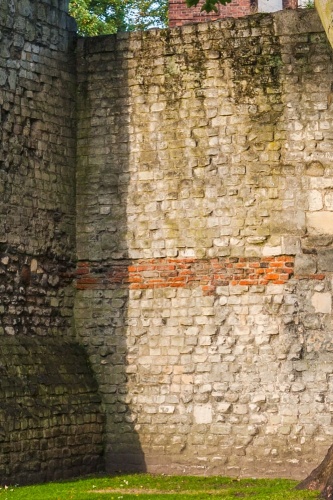
Within the open side of the Tower, accessed from the rear, are four Roman coffins. These were brought here from Roman burial sites across York.
The name Multangular Tower did not appear before 1683 when it was used by Dr Martin Lister of the Repository of the Royal Society. This group took on the task of cataloguing the historic remains of Britain. Before that time the Tower had been known by several names. In 1315 it was called Ellerandyng and in 1380 it was recorded as Elrondyng. The root word elleran may come from eller, meaning old.
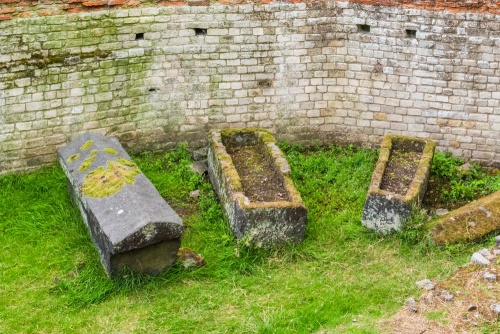
Facts and figures
The Multangular Tower is 30 feet high and has an external diameter of 48.5 feet including the plinth or 46 feet above it. The 10 sides are of different length, from 7.5 to 11 feet. The tower foundation is concrete and the construction consists of ashlar courses encasing a core of mortar and rubble stone. The bottom 20 feet of the Tower is original Roman construction while the top 10 feet is medieval.
During the Civil War period, the Tower seems to have been filled up with earth to reinforce the stone defences. When the interior was finally excavated a carved stone was revealed with a Latin inscription reading 'Genio loci feliciter', which translates loosely as 'Good luck to the Genius of this place'. in this case, the word 'genius' means the spirit of the place, similar to the idea of a guardian spirit.
In front of the Tower is a modern commemorative stone inscribed with these words:
The Multangular Tower
This tower formed the north-west corner of the Roman Legionary Fortress of Eboracum.
It was built about 300A.D. on the site of an older and simpler tower. The larger stonework at the top is Medieval.
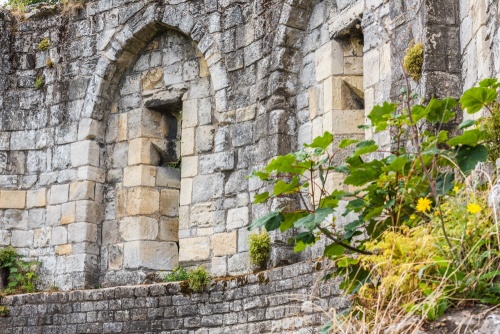
Getting There
The Multangular Tower lies within Museum Gardens, accessed off Museum street. Just follow pedestrian signs for the Yorkshire Museum. You will find the Tower a stone's throw from the museum building.
While you can certainly enjoy views from the Museum Garden, I highly recommend taking the path that leads beside the Tower and through a doorway in the city wall. Turn right after you pass through the doorway and you can see the back of the tower. This gives you a much better idea of how the Tower was built. It is also very close to the Anglian Tower, built as early as the 7th century.
About Multangular Tower
Address: Museum Gardens, Museum Street, York,
Yorkshire,
England
Attraction Type: Roman Site
Location: In Museum Gardens between the Yorkshire Museum and St Leonard's hospital ruins.
Location map
OS: SE599520
Photo Credit: David Ross and Britain Express
HERITAGE
 We've 'tagged' this attraction information to help you find related historic attractions and learn more about major time periods mentioned.
We've 'tagged' this attraction information to help you find related historic attractions and learn more about major time periods mentioned.
Find other attractions tagged with:
NEARBY HISTORIC ATTRACTIONS
Heritage Rated from 1- 5 (low to exceptional) on historic interest
St Leonard's Hospital - 0 miles (Historic Building) ![]()
Yorkshire Museum - 0 miles (Museum) ![]()
Museum Gardens - 0.1 miles (Garden) ![]()
St Mary's Abbey, York - 0.1 miles (Abbey) ![]()
King's Manor - 0.1 miles (Historic Building) ![]()
Anglian Tower - 0.1 miles (Historic Building) ![]()
York, St Helen Stonegate - 0.1 miles (Historic Church) ![]()
St Wilfrid's Catholic Church - 0.1 miles (Historic Church) ![]()




